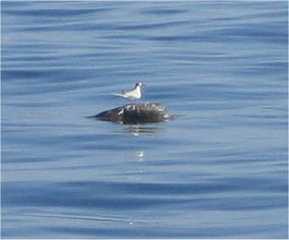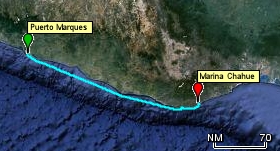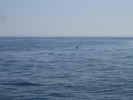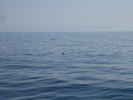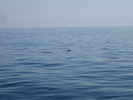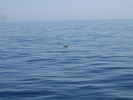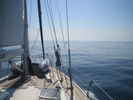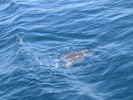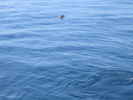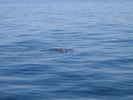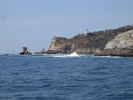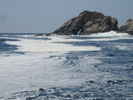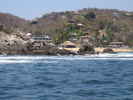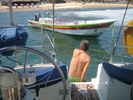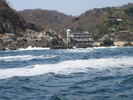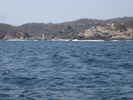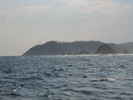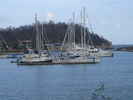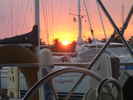242 nm Passage to Huatulco (Marina Chahue), including Puerto AngelIt was a moderately eventful voyage from Puerto Marques down to Huatulco. Getting up when the alarm clock went off at 3:00 am, on Monday, March 10th, I proceeded to get Rhapsody ready to make way from Puerto Marques. As I took off the canvas, turned on the instruments and nav lights, and started the motor, I noticed that the bow navigation light was burned out, so I took about 10 minutes to open it up and replace the light bulb in the dark. Then I started the motor, turned on the power to the windlass and began to weigh anchor. The windlass worked without a hitch and the anchor came up cleanly. The two hotels lining the shore provided enough light for me to clean up the bow and secure the anchor. There was virtually no wind, so there was no rush, once I got the anchor up, to get back to the helm. I calmly put the boat in gear and followed the track on the chartplotter that we had created when arriving two days before. An hour later, as I was standing over the dodger, scanning the still very dark horizon, I looked up and was slightly alarmed for a second to see spooky black shapes blotting out the stars above me. When I pointed a flashlight towards the sky, the black shapes turned out to be frigate birds that were coasting along on the uplift caused by Rhapsody breaking the slight, 5-7 knot wind. I decided to help them along by letting out some sail, but soon they disappeared. Perhaps they didn't like the attention. The sky lightened at 5:30 am, I had a bowl of cold cereal, and the sun rose on a beautiful warm day. At about 6:30 am, I checked email on the SSB, retrieving the programmed weather forecasts over a somewhat slow, noisy connection. We decided to do a little fishing, so we put a line in the water with a new lure ... a bright green one with tinsel ... and waited to catch some fish :-) I was below at about noon when the reel made the excitting "zipping" noise!! Rushing up to the deck as the line on the reel was playing out, I threw the ratchet to set the hook, seeing a large fish jump out of the water about 200 yards behind the boat at the same time. Unfortunately, the hook did not set and the line went slack in my hands. Sigh, I hate that, because I'm sure he was a big one! All around us, and all thru the day, we had been, and kept seeing various sailfish, mostly Swordfish, but possibly some Marlins too, jumping out of the water within 1/2 mile of the boat. These large, 6 foot+, fish are spectacular. When they leap up out of the water, presumably showing off, or perhaps at the end of a run for food, they glitter in the sunlight and make a huge splash when they come back down. Throughout the day we probably saw 15-20 of them, mostly singly, but sometimes in small groups. Also, we saw tons of Dolphins, perhaps 30-40 in total, with many of them coming up to the boat to play in the bow wave. But perhaps the neatest sight of the day were the Turtles. We counted well over 100 turtles in the 5 hours from 8 am to 1 pm. Often the boat would come within 10-20 yards of one, and he would scurry for the safety of deeper water ... Dive, Dive, Dive! But the funniest sight of all were the Turtles with Birds on their backs. We probably saw 30 or so of these, where the Turtle, aware or not, for whatever symbiotic reason, would have a small, or sometimes larger, sea bird on his/her back as he swam slowly on his way. Speculating, we decided that the birds were not really using the turtles as a means of transportation, being so swift themselves, but were merely resting on the turtles. Who knows what benefit, if any, the Turtle received from the deal :-) After lunch, we put the sails down. The boat was pretty rolly with no sails up, so after a while, I put the mainsail out 2/3's of the way, which seemed to ease the rolling. The sun set, the quarter moon not far behind it, and soon it was completely dark except for Rhapsody's running lights and the light from the chartplotter on the helm. I passed the next hours, between getting up and scanning the blank horizon, by reading a book by the light of the chartplotter. I kept seeing these flashes from the shore, and wondered if I was seeing artillery or the flash from mining explosions or something, because the sky was completely clear and there were no clouds to be detected. After awhile, it became apparent that it was in fact lightning, as the flashes began to illuminate the outline of some very high mountains, about 30-40 miles inshore. We stand on the helm seats to look over the dodger, as it gives the best view of the front of the boat, rather than looking thru the plastic windows of the dodger itself. So, after another scan of the horizon and watching 10 or so lightning flashes, I returned to the helm to check the radar and chartplotter. That's when the excitement started. There was now a distinct radar return from a vessel dead ahead of us, about 6 miles away, on the radar.Our radar has a feature called MARPA, which stands for something like "Minature Automated Radar Plotting and Acquisition". This features allows one to track targets and automatically calculates their course and speed. When I put the cursor on the return from the vessel and pressed the "Acquire Target" button, the radar told me that the boat was on a direct collision course with us at a speed of 18-20 knots. However, when I got up and scanned the horizon carefully, I could not make out any running lights on the vessel. This was not good. It was midnight, and we were on the most desolate stretch of coast (Oaxaca) since we'd left Baha California. Almost 200 miles with only a few lights here and there, and, as there was no moon out, it was completely dark, except for the faint starlight. Usually one can see another boat in these conditions in excess of 10 miles, so I was immediately very concerned. Everyone has heard rumors of pirates and this boat was behaving very suspiciously. And at 18 knots, they would be on us in less than 15 minutes. Frankly, because I was a little scared myself, after a few more minutes of alternately anxiously watching the radar and scanning the horizon, still seeing no running lights, I went below and woke the mate up, telling her that there was an unlit, unidentified boat making 18 knots on an apparent collision course with us. I also grabbed the flare gun and pepper spray, the only defensive weapons we keep on board, and brought them back on deck with me. Understandably she was a little disoriented when she came up. We quickly discussed our options. In retrospect, I should have called the mystery boat on the radio, but out of fear, because somewhere I had heard a rumor that it was a bad idea to announce your presence to potential pirates on the VHF, I didn't. Instead, the first thing I did was alter our course 30 degrees to starboard, away from the land, and hopefully away from the strange boat. As the strange boat passed us port to port, I was able to make it out, barely (due to its cabin lights), with the binoculars. After it passed us, it began turning around to come back towards us, causing us to become even more concerned. I increased our speed from 6 knots to 7, nearly our top speed, to try to get some distance. I can't tell you how slow a sailboat feels when another boat is bearing down on you in the dark at 20 knots! About then, I looked on the chartplotter, and thanks to the AIS (Automatic Identification System) that I had installed, I saw a freighter about 15 miles further out to sea and got their name, COASTAL INSPIRATION, from the chartplotter. I got on the VHF and made a call "Coastal Inspiration, Coastal Inspiration, this is Sailing Vessel Rhapsody, come in please", as the strange boat began closing on us, less than 1/2 mile away. I told the mate to take the pepper spray and go below and be prepared to put the boards up and lock ourselves in if any trouble occurred. Still getting no response on the VHF, I called on the radio again, "Coastal Inspiration, Coastal Inspiration, this is Sailing Vessel Rhapsody at 15 56 north 96 20 west. Be advised that we have an unidentified unlit vessel approaching us in an aggressive manner. Pan Pan!" Thru the binoculars I could now see the mystery boat was a large vessel, perhaps 200 feet in length, and I started to feel better. It was more likely the Mexican Navy than a pirate, who would use a smaller boat. Then a hugely bright spotlight came on, flooding Rhapsody in light, the dark, strange boat only 100 yards or so away. There was still nothing on the radio. I stood where I, and my hands, could be clearly seen and tried to look as unaggressive as possible! Then I walked over to the radio and called out, somewhat nervously, "Unidentified vessel off my starboard beam, this is the sailing vessel Rhapsody, please identify yourself!". Never once did they identify themselves directly. The voice on the radio, laconically, in pretty good English, came back with something like "Sailing Vessel, what is your boat's name?". I replied "Rhapsody", and spelled it out for him. Then he asked what nationality we were. I said we were from the United States of America. I think he said "ok". Then I asked him if he was the Mexican Navy, and he somewhat indirectly said yes he was. I told him that I had been concerned being approached by an unlit, unidentified vessel, and generally conveyed that we were scared and harmless. After a few minutes, the spotlight went off, and the boat started moving away from us. I called him on the radio one more time and said that, with his permission, we were going to correct 30 degrees back to original course. He said "ok" and that was basically it. The adrenaline was running pretty good at that point. The freighter I had called earlier, COASTAL INSPIRATION, called Rhapsody and asked to switch to channel 6, which I did. We chatted for a few seconds and he got my position, told me he could not see me on radar, but expressed his opinion that the vessel I had seen was not likely the Mexican Navy. I told him I thought everything was ok and that I was cancelling the Pan (a marine alert) and returning to monitor channel 16. As the "mystery boat" picked up speed moving away from us (I was still tracking it with Marpa), I noted that not once had he ever identified himself, and that only when I had asked "are you the Mexican Navy?" had he barely replied "yes". We spent about 30 minutes discussing the possible psychology of the situation, how these guys (navies and coast guards) actually LIKE to scare us, put us on the defensive and so forth. I was reminded that even in the USA, like when we were sailing Mandala in '06, and a private-looking helicopter had ordered us to change course near Anacapa Is., and they had never identified themselves as the US Navy. Navy ships, no matter the country, never send out AIS signals, and do everything they can to be sneaky, that's all I can say. In retrospect, perhaps my evasive maneuvers also seemed suspicious to him. Thank goodness I hadn't turned off my running lights, a thought that had crossed my mind at one point. Surely we would have been boarded and who knows what kind of confusion might have resulted. In the future, I've decided that if I am again approached by an unlit, unidentified vessel in the middle of the night, that I WILL hail them on the radio. I figure the odds are much better that you will be approached by the navy than a pirate, say 100 to 1, and perhaps if I had been more straightforward in my approach, it would have lessened the suspicion and fear on both sides of the fence. And if it is a pirate, what are you going to do anyway? So, after about an hour of talking, at 1:00am or so, I finally went below and read a bit to calm myself down. Then, later, on my watch, 5-10 dolphins swam up and started playing in Rhapsody's bow wave. As they swiftly swam their wispy, ghostlike paths of phospholuminescence, they would disturb some kind of creatures that gave off a footsized bright flash of light that looked like photo bulbs going off under water. One time, 3 or 4 dolphins swam together as a group, creating many, scattered, very bright flashes. It was very pretty. I served the rest of my watch, then went below to rest so that I'd be fresh when we pulled into Puerto Angel at about noon. When we got to Puerto Angel, it was about 1:00 pm. We were both pretty tired and looking forward to parking the boat and getting some rest. But as we pulled into the little bay we were immediately disappointed. Although the Rains' book had said that it was a good anchorage, the swells were running pretty high, and the two locations that were recommended for dropping the hook were crowded with Pangas on anchor. Worse than the Pangas tho were the loose anchor lines, floating yellow polypropylene, that were haphazardly drifting about the anchorage. We went to the northern little cove, Rains' favorite, and were trying to maneuver our way into the swelly anchorage when we accidentally ran across one of these floating lines and it got fouled in our propeller. Great! Yet another problem, and this when we were somewhat sleep-deprived and merely looking for a good place to stop. With no propeller, in a small cove with a 2-3 foot swell running, I had no choice but to hastily drop the hook where we were, without setting it, and then jump into a swimsuit, don a mask and fins, and dive under the boat to free the line from the propeller. Fortunately, it wasn't badly fouled and in 5 minutes or so I had it cleared. We then gathered up the stray ropes floating on the water immediately around us. When we pulled them even slightly, the rebar anchors holding them down broke free, so, for safety's sake, I went ahead and brought two of the anchors, along with their rats' nests of yellow rope, aboard before starting the motor. Once they were aboard, we started Rhapsody's motor, lifted up our anchor, and began making way. As we did, we tossed the two rebar anchors and messes of line off the back, and quickly mutually decided to leave Puerto Angel altogether and proceed directly to Marina Chahue, in Huatulco, about 30 additional miles east. So, a quick note to cruisers: Puerto Angel may be good in some conditions, but there are a lot of Pangas, and larger boats should probably not bother trying to anchor there. A big, crashing swell can run into the bay to the anchorages shown in the Rains' book.Finally, at about 5:00 pm, after being out more than 36 hours, we rounded Piedra Blanco into Bahia Huatulco and made the channel into the Chahue Marina. We were very pleased to be greeted with a clean, well-run marina. We pulled up to the first end-tie after speaking with departing NOKIA on the radio, who gave us the skinny on getting into the marina. A few minutes later, Enrique, the marina manager, came by and told us that we could stay on the end tie for the night but it would be better for us to move into a slip the following day. Whew. It had been a long night and stressful passage. We drank our dinner that night, having a couple of shots and beers each as I strummed the guitar, then we bedded down safe and secure for the night in Huatulco. |
